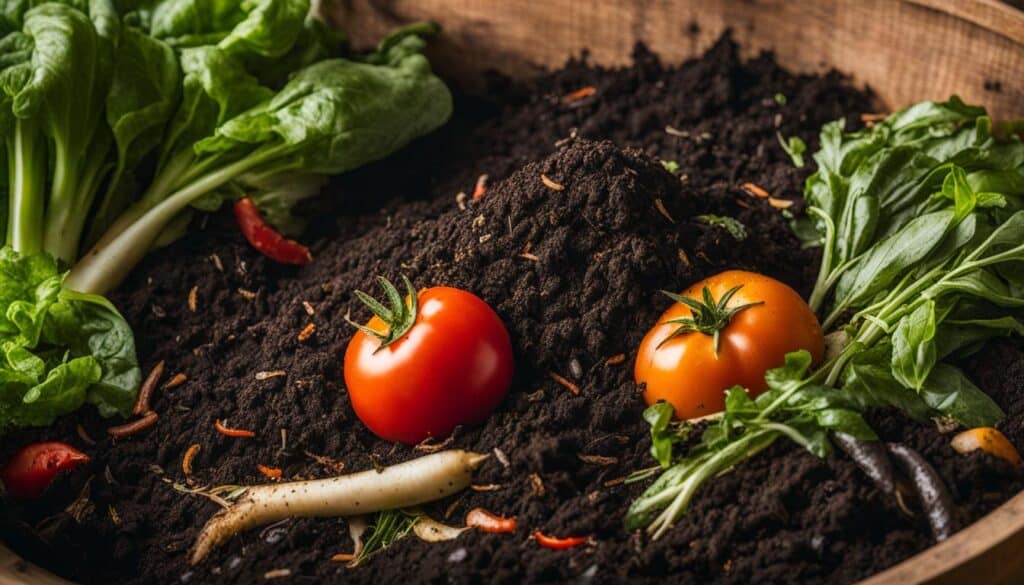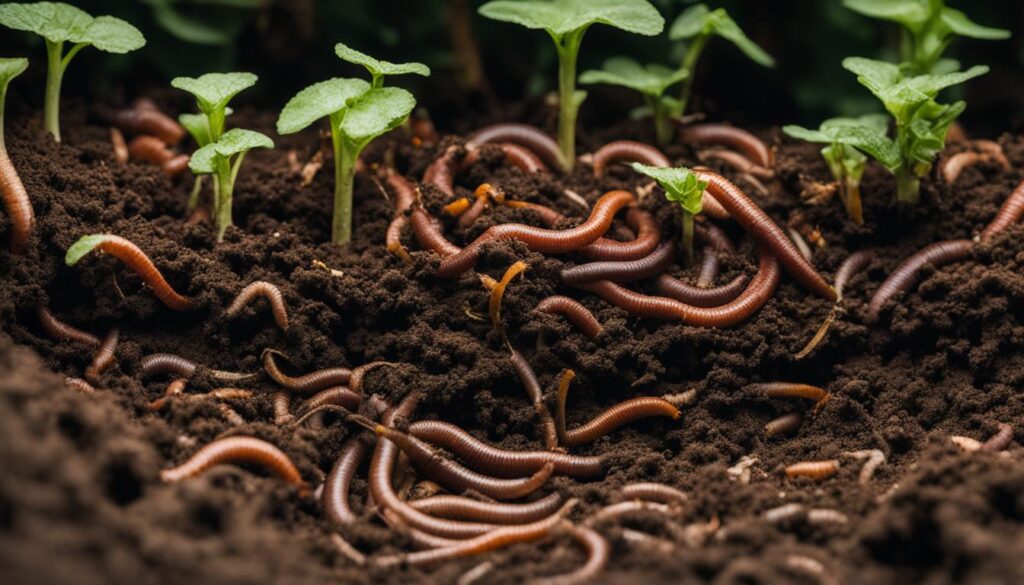Hugelkultur beds are a sustainable and innovative gardening technique that harnesses the benefits of wood decomposition and layering plant matter to create moisture-holding beds. To ensure the success of your hugelkultur garden, it is essential to choose the best plants that can thrive in this unique ecosystem.
When selecting plants for hugelkultur beds, it is important to consider their ability to withstand climate instabilities, hold moisture, and benefit from the active soil web. There are a variety of recommended plants for hugelkultur gardening, including perennials, native plants, low-maintenance options, and high-yield varieties.
By carefully selecting the right plants, you can create a thriving and sustainable hugelkultur garden that will reward you with a bountiful harvest and a beautiful landscape. In this article, we will explore the best plants for hugelkultur beds and provide recommendations to help you create your own thriving hugelkultur garden.
Key Takeaways:
- The best plants for hugelkultur beds are those that can withstand climate instabilities, hold moisture, and benefit from the active soil web.
- Recommended plants for hugelkultur gardening include perennials, native plants, low-maintenance options, and high-yield varieties.
- By selecting the right plants, you can create a thriving and sustainable hugelkultur garden that will reward you with a bountiful harvest and a beautiful landscape.
- Consider the specific conditions of your hugelkultur bed, such as sun exposure, moisture levels, and soil fertility, when choosing plants.
- Perennial plants, including herbs, flowers, and shrubs, are well-suited for hugelkultur beds as they can establish long-lasting root systems and benefit from the nutrient-rich soil.
Benefits of Hugelkultur Beds
Hugelkultur beds offer numerous advantages over traditional garden beds, making them an attractive option for eco-conscious gardeners. One of the key benefits of hugelkultur beds is their excellent water retention capabilities. The decomposing wood and plant matter create a sponge-like structure that can hold moisture for extended periods. This makes hugelkultur beds particularly well-suited for areas with limited water resources or frequent droughts.
Another advantage of hugelkultur beds is the enhancement of soil fertility. As the wood decomposes, it releases nutrients into the soil, creating a rich and fertile growing environment. This process also fosters the growth of beneficial microorganisms and organisms, such as earthworms, which contribute to a thriving soil web. Better soil health translates into healthier plants with increased resistance to pests and diseases.
Hugelkultur beds are also a cost-effective gardening technique. They allow you to utilize waste wood that would otherwise go to landfill or require disposal. Instead, this wood is repurposed to create productive garden beds. By repurposing organic materials, hugelkultur beds promote sustainability and reduce the need for additional inputs such as fertilizers and pesticides.
“Hugelkultur beds offer excellent water retention capabilities, enhance soil fertility, and are a cost-effective gardening technique.”
Furthermore, hugelkultur beds contribute to the sequestration of carbon dioxide, a key greenhouse gas responsible for climate change. The decomposition process in the beds allows organic matter to store carbon, reducing its release into the atmosphere. This makes hugelkultur beds an environmentally friendly gardening option that can help mitigate climate change.
Table: Comparing the Benefits of Hugelkultur Beds
| Benefit | Description |
|---|---|
| Excellent water retention | Hugelkultur beds can hold moisture for extended periods, reducing the need for frequent watering and making them ideal for dry climates or areas with limited water resources. |
| Enhanced soil fertility | The decomposition of wood and organic matter in hugelkultur beds releases nutrients into the soil, promoting the growth of healthy plants with increased resistance to pests and diseases. |
| Cost-effective gardening | Hugelkultur beds allow for the utilization of waste wood, reducing disposal costs and the need for additional inputs such as fertilizers and pesticides. |
| Carbon sequestration | The decomposition process in hugelkultur beds helps store carbon dioxide, contributing to the reduction of greenhouse gas emissions and mitigating climate change. |
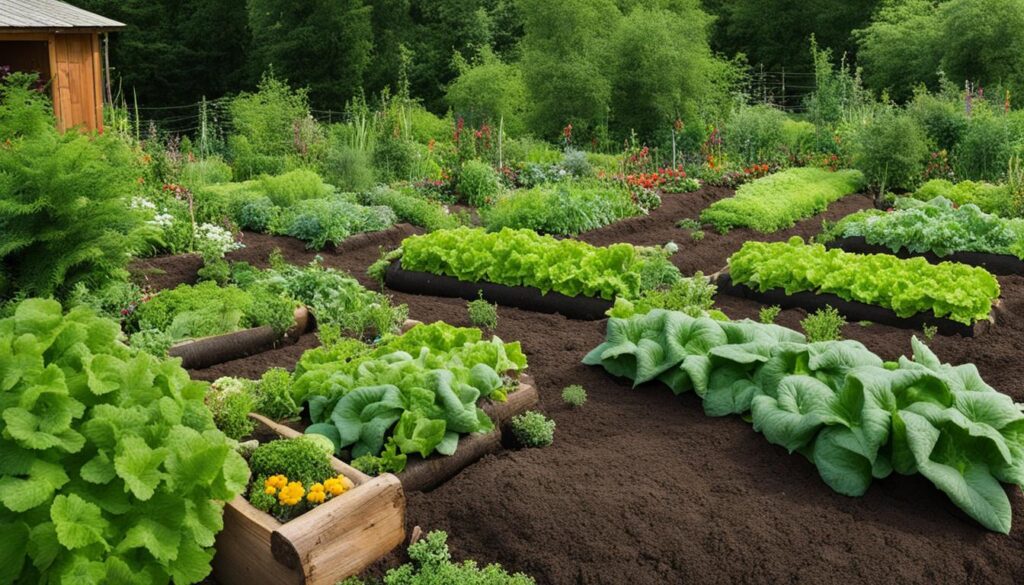
By incorporating hugelkultur beds into your gardening practices, you can enjoy these benefits while creating a sustainable and resilient garden. Whether you are looking to conserve water, improve soil fertility, save money, or contribute to environmental efforts, hugelkultur beds offer a versatile and eco-friendly solution.
Types of Hugelkultur Beds
When it comes to implementing the hugelkultur gardening technique, there are two main types of beds to consider: in-ground and above-ground. Each type has its own unique characteristics and benefits, allowing gardeners to choose the option that best suits their needs and preferences.
In-Ground Hugelkultur Beds
In-ground hugelkultur beds are created by digging a pit and filling it with logs, branches, and plant matter. This method allows for maximum utilization of available space and is suitable for any garden setting. These beds can be planted almost immediately, as the decomposition process begins and creates a nutrient-rich soil environment. In-ground hugelkultur beds are particularly ideal for areas with limited space, as they can be built in small backyard gardens or even on balconies.
Above-Ground Hugelkultur Beds
Above-ground hugelkultur beds, on the other hand, are constructed by piling up logs, branches, and soil to create mounds. These beds take longer to season and require a bit more time before planting can occur, but they offer several advantages. The height of above-ground beds can be customized to suit individual preferences, allowing for the creation of raised beds that are more accessible for planting, maintenance, and harvesting. These mounds also create natural microclimates, providing different growing conditions within the same garden space.
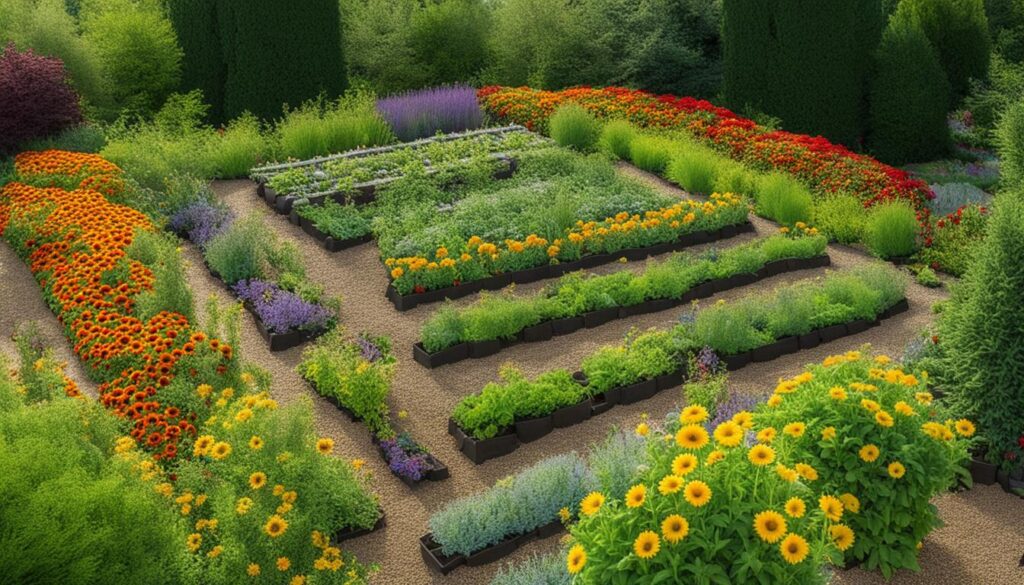
Both in-ground and above-ground hugelkultur beds have their own unique benefits, and the choice between the two ultimately depends on the specific goals, preferences, and available space of the gardener. Whether you opt for the simplicity of an in-ground bed or the versatility of an above-ground mound, embracing the hugelkultur technique can lead to a thriving and sustainable garden.
How to Build Hugelkultur Beds
Building a hugelkultur bed is a straightforward process that involves a few key steps. By following these steps, you can create a sturdy and productive hugel bed for your garden. Here are the essential steps to consider:
- Prepare the site: Choose a suitable location for your hugelkultur bed. Clear the area of any weeds or vegetation.
- Gather materials: Collect the necessary materials, including logs, branches, compost, and topsoil. The type of wood you use will impact the decomposition rate and nutrient release, so choose accordingly.
- Build the base: Start by creating a base layer of logs or larger woody materials. This layer will provide structure and help retain moisture. Arrange the logs in a compact manner, ensuring they cover the entire bed area.
- Add layers: Layer the bed with branches, twigs, leaves, and other organic materials. These layers will further promote moisture retention and decomposition. Aim for a varied mix of materials to create a diverse and nutrient-rich environment.
- Top it off: Finish the bed by covering the organic layers with a layer of compost and topsoil. This will provide a fertile growing medium for your plants.
- Water and settle: Water the bed thoroughly, allowing the materials to settle and compact. This will help prevent excessive settling later on.
- Plant and maintain: Once the bed has settled, it’s time to plant your desired plants. Water them regularly, especially during the initial stages as the bed establishes itself.
Remember that building a hugelkultur bed is a long-term investment. It may take several months or even a year for the bed to fully mature and for the decomposition process to release nutrients into the soil. Regular maintenance, including watering and occasional addition of organic matter, will help support the growth of your plants.
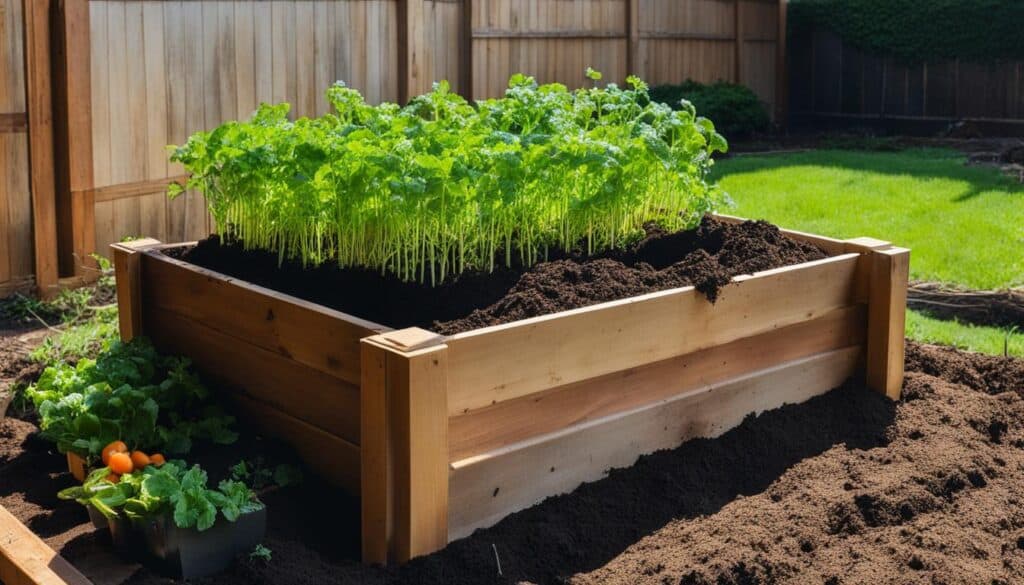
Table: Materials for Hugelkultur Bed Construction
| Materials | Description |
|---|---|
| Logs | Durable hardwood or softwood logs for the base layer of the bed. |
| Branches | Small to medium-sized branches for layering on top of the logs. |
| Leaves | Dry leaves for adding organic matter and promoting decomposition. |
| Compost | High-quality compost to provide nutrients and enhance soil fertility. |
| Topsoil | Healthy topsoil to create a suitable growing medium for plants. |
Using the right materials and following the construction process will ensure the success of your hugelkultur bed. With time, your bed will develop a thriving ecosystem and provide a sustainable and productive environment for your plants.
Recommended Wood and Materials for Hugelkultur
When building a hugelkultur bed, it is important to choose the right wood and materials. The type of wood used in the construction of the bed will determine its longevity and nutrient-release capabilities. Hardwoods such as oak, maple, and beech are ideal choices as they decompose slowly and provide a steady release of nutrients over time. Softwoods like pine and spruce can also be used, but they decompose more quickly and may require additional replenishment of organic matter.
In addition to wood, there are other materials that can be incorporated into the hugelkultur bed to enhance its structure and fertility. Branches and twigs can be layered with the wood to create air pockets and improve drainage. Leaves, straw, and compost can be added to increase the organic matter content and provide a source of nutrients for the plants. Manure can also be used to introduce beneficial microorganisms and enrich the soil.
“The type of wood used in hugelkultur beds determines their longevity and nutrient release.”
— Hugelkultur enthusiast
Table: Recommended Wood and Materials for Hugelkultur Beds
| Materials | Benefits |
|---|---|
| Hardwoods (oak, maple, beech) | Slow decomposition, long-lasting nutrient release |
| Softwoods (pine, spruce) | Quick decomposition, may require additional organic matter |
| Branches and twigs | Create air pockets, improve drainage |
| Leaves, straw, compost | Increase organic matter, provide nutrients |
| Manure | Introduce beneficial microorganisms, enrich soil |
By selecting the appropriate wood and materials, you can create a productive and nutrient-rich hugelkultur bed that supports the growth of a wide range of plants. It is important to consider the specific requirements of your plants and the local climate when choosing materials for your bed. Experimentation and adaptation based on local conditions can lead to the most successful and sustainable hugelkultur gardening experience.
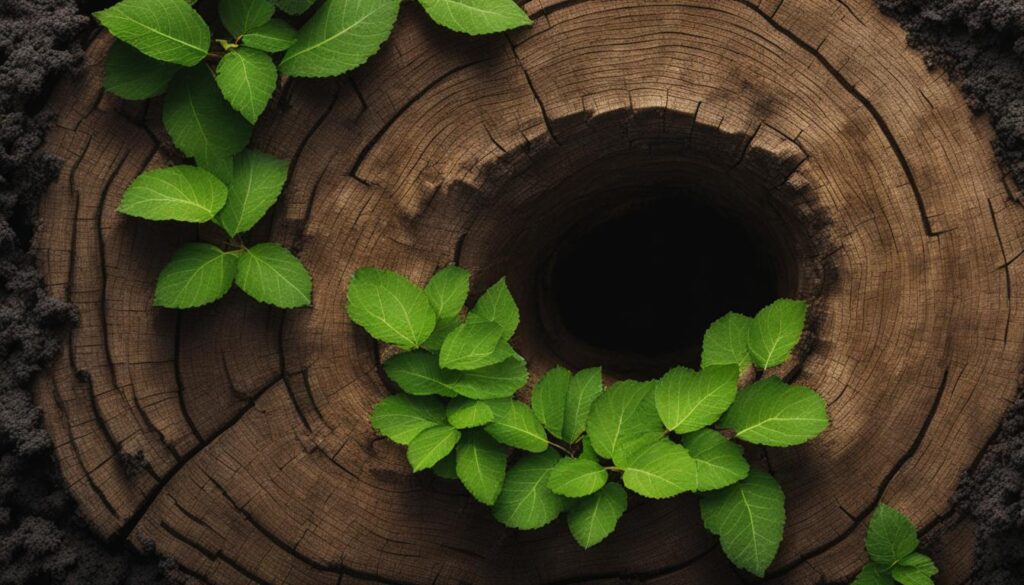
Pros and Cons of Hugelkultur Beds
Hugelkultur beds have gained popularity in recent years due to their numerous advantages. However, like any gardening technique, they also have some drawbacks to consider. Understanding the pros and cons of hugelkultur beds can help you make an informed decision about whether this gardening method is right for you.
Advantages of Hugelkultur Beds
- Water Retention: Hugelkultur beds have excellent water retention capabilities, reducing the need for frequent watering and making them suitable for dry climates.
- Soil Fertility: The decomposition of wood in hugel beds creates nutrient-rich soil, providing a fertile environment for plant growth.
- Sustainable: Hugelkultur beds offer an eco-friendly way to garden, utilizing waste wood and organic materials that would otherwise go to waste.
- Increased Surface Area: Hugelkultur beds create additional planting space on top of the mounds, maximizing the use of space in your garden.
- Cost-Effective: Building hugelkultur beds can be a low-cost solution, especially if you have access to free or inexpensive wood and organic materials.
“Hugelkultur beds provide a sustainable and cost-effective way to garden, with excellent water retention capabilities and increased surface area for planting.”
Disadvantages of Hugelkultur Beds
- Labor and Materials: Building hugelkultur beds requires initial labor and access to materials such as logs, branches, compost, and soil.
- Nitrogen Lock: In the early stages of decomposition, the wood in hugelkultur beds may temporarily immobilize nitrogen, affecting plant growth. Adding nitrogen-rich materials and fertilizers can help mitigate this issue.
- Pests and Diseases: Hugelkultur beds may attract pests and diseases, which can pose challenges for gardeners. Regular monitoring and appropriate treatment are necessary to maintain the health of your plants.
Considering the advantages and disadvantages of hugelkultur beds, it is important to assess your own gardening goals, resources, and preferences. While they offer numerous benefits, they may not be suitable for every garden or gardener. To make an informed decision, evaluate the specific conditions of your garden and weigh the pros and cons of hugelkultur gardening.
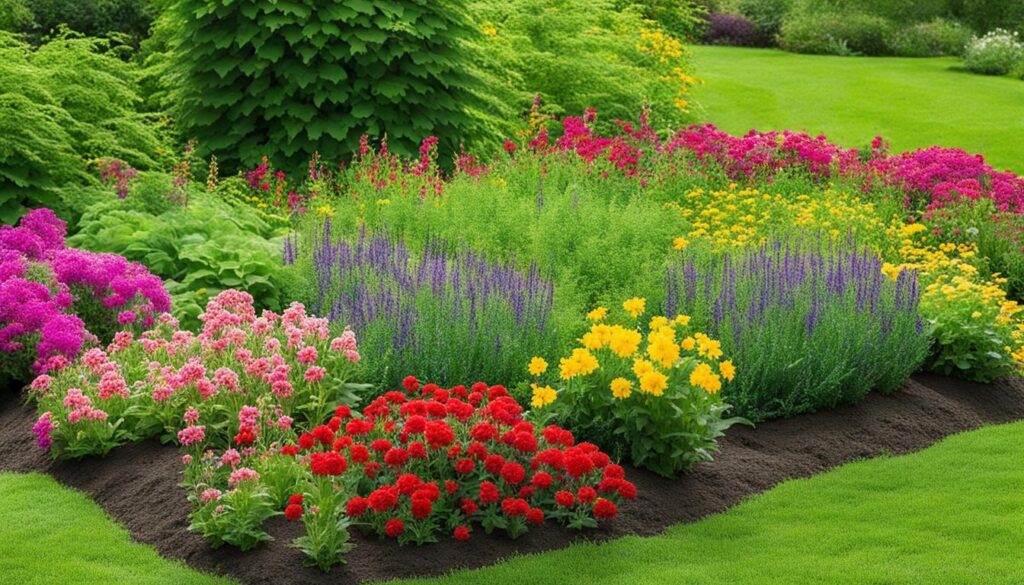
Plant Selection for Hugelkultur Beds
Choosing the right plants is a crucial step in creating a successful hugelkultur bed. Consider the specific conditions of your bed, such as sun exposure, moisture levels, and soil fertility, when making plant selections. Perennial plants, including herbs, flowers, and shrubs, are well-suited for hugelkultur beds. They can establish long-lasting root systems and benefit from the nutrient-rich soil created by the decomposing wood. Native plants are also recommended as they are adapted to the local climate and soil conditions, making them more resilient. By selecting native species, you can create a habitat that supports local biodiversity and requires less maintenance.
It is also beneficial to choose low-maintenance plants for your hugelkultur bed. These plants can thrive with minimal care, reducing the need for regular maintenance tasks. High-yield varieties are another excellent choice, as they can maximize the productivity of your bed. These plants are known for their abundant harvests, allowing you to enjoy a bountiful harvest from your hugelkultur garden. When selecting plants, consider their growth habits, nutritional requirements, and compatibility with the overall design of your bed.
To further assist you in plant selection for your hugelkultur bed, below is a list of recommended plants that are suitable for this gardening technique:
| Plant | Sun Exposure | Watering Needs | Height |
|---|---|---|---|
| Rosemary | Full Sun | Low | 1-3 feet |
| Lavender | Full Sun | Low | 1-3 feet |
| Echinacea | Full Sun to Partial Shade | Moderate | 2-4 feet |
| Black-eyed Susan | Full Sun to Partial Shade | Moderate | 2-3 feet |
These plants are just a few examples of the many options available for your hugelkultur bed. Remember to also consider the aesthetic appeal, pollinator-attracting qualities, and your personal preferences when selecting plants. With careful plant selection, your hugelkultur bed can become a thriving and beautiful garden that offers both visual enjoyment and bountiful harvests.
Tips for Maintaining Hugelkultur Beds
Maintaining hugelkultur beds is essential to ensure their long-term success and productivity. By following a few simple tips, you can keep your hugelkultur garden thriving and healthy.
Watering:
Regular watering is important, especially during the initial stages of bed establishment. Hugelkultur beds have excellent water retention capabilities, but it’s still important to monitor soil moisture levels. Water deeply and less frequently to encourage deep root growth and prevent waterlogging.
Mulching:
Mulching with organic materials such as straw or wood chips can help conserve moisture, control weeds, and regulate soil temperature. Apply a thick layer of mulch around the plants, leaving space around the stems to prevent rot. Mulching also adds organic matter to the bed, improving soil fertility over time.
Adding Compost:
Periodically adding compost for your vegetable garden or hugelkultur bed can replenish nutrients and enhance the soil’s fertility. Spread a layer of compost on top of the bed and gently work it into the topsoil. This will provide a slow-release source of nutrients for your plants and support the overall health of the bed.
Pruning and Trimming:
Regular pruning and trimming of plants in your hugelkultur bed is necessary to prevent overcrowding and maintain their health and vigor. Remove dead or diseased branches, and trim back any excessive growth. Pruning also helps improve air circulation and light penetration, reducing the risk of pests and diseases.
Pest and Disease Management:
Monitor your hugelkultur garden regularly for any signs of pests or diseases. Early detection and prompt action are crucial in preventing the spread of pests and diseases. Remove affected plants or infected parts, and consider natural pest control methods such as introducing beneficial insects or using organic sprays if necessary.
By following these tips for maintaining hugelkultur beds, you can create a thriving and sustainable garden that continues to provide abundant harvests year after year.
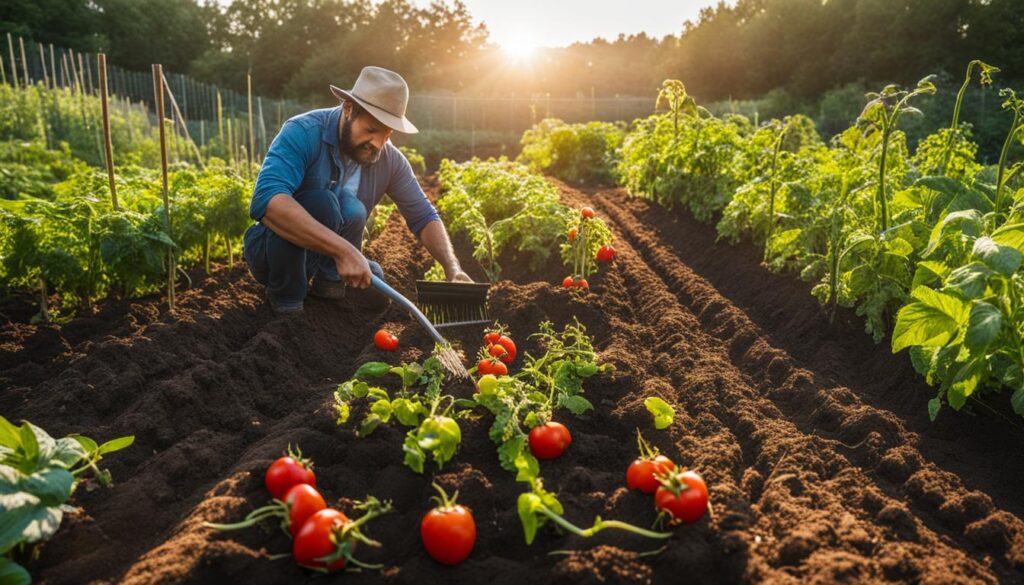
Common Issues in Hugelkultur Beds
While hugelkultur beds are generally low-maintenance, there are some common issues that may arise. Understanding and addressing these issues promptly will help ensure the health and productivity of your hugelkultur garden.
Nitrogen Lock
One of the common problems in hugelkultur beds is nitrogen lock, where wood temporarily immobilizes nitrogen, affecting plant growth in the early stages. To address this issue, add nitrogen-rich materials such as grass clippings, coffee grounds, or blood meal to the bed. Additionally, using a nitrogen-rich organic fertilizer can help provide the necessary nutrients for plant growth.
Poor Drainage
If your hugelkultur bed becomes too compacted, poor drainage can occur, leading to waterlogging and potential root rot. To improve drainage, consider adding drainage elements such as gravel or perforated pipes at the bottom of the bed. This will allow excess water to flow out, preventing waterlogging and maintaining optimal soil conditions for plant growth.
Pests and Diseases
Like any garden, hugelkultur beds can be susceptible to pests and diseases. It is important to regularly monitor your plants for any signs of pests or diseases and take appropriate action. Identify the specific pest or disease and apply suitable organic remedies or treatments to protect your plants. Implementing good garden hygiene practices such as removing diseased plant material and practicing crop rotation can also help prevent the spread of pests and diseases.
By troubleshooting these common issues in hugelkultur beds, you can ensure the long-term success and productivity of your garden. Regular observation, timely intervention, and proper care will create a thriving and sustainable hugelkultur ecosystem.
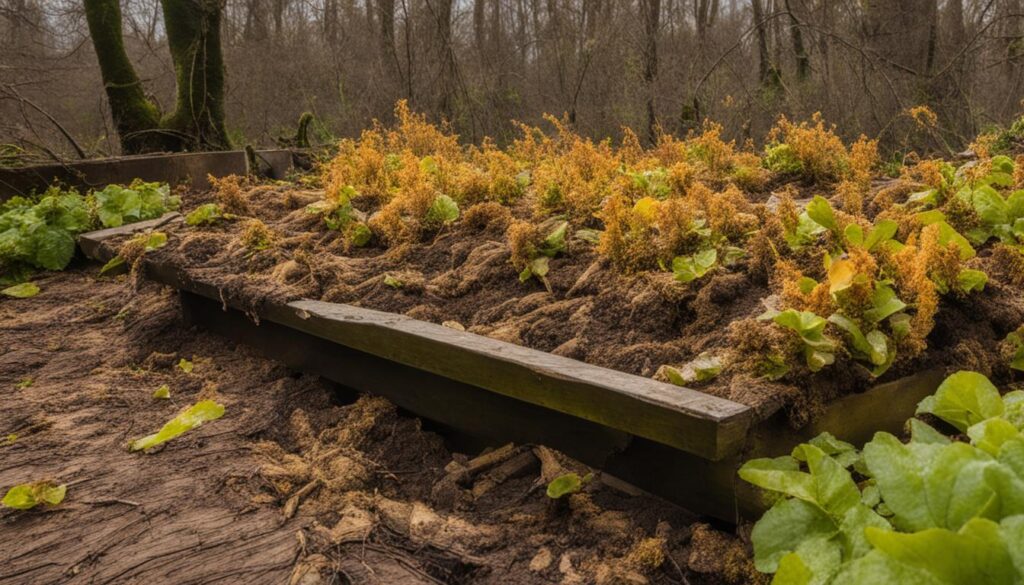
Conclusion
Overall, hugelkultur beds are an innovative and sustainable gardening technique that offers numerous benefits for plant growth and soil health. By selecting the best plants for your specific hugelkultur bed, properly building and maintaining it, and troubleshooting any issues that may arise, you can create a thriving and productive garden.
When considering the plants for your hugelkultur bed, take into account the sun exposure, moisture levels, and soil fertility of your specific bed. Perennial plants, especially native varieties, are well-suited for hugelkultur beds due to their ability to establish strong root systems and thrive in the nutrient-rich soil. Additionally, low-maintenance plants and high-yield varieties can enhance the productivity of your garden.
Proper maintenance is key to the long-term success of your hugelkultur bed. Regular watering, mulching, and periodic addition of compost and organic matter will help retain moisture, suppress weed growth, and replenish nutrients. It is also important to prune and trim plants as needed to prevent overcrowding and ensure their health. By monitoring for pests and diseases and addressing them promptly, you can maintain a thriving hugelkultur garden.
In conclusion, by considering the specific conditions of your site, choosing the right plants and materials, and providing proper care and attention, you can create a sustainable and resilient garden with hugelkultur beds. Embrace this innovative gardening technique and enjoy the rewards of a thriving ecosystem that supports healthy plant growth.
FAQ
What are hugelkultur beds?
Hugelkultur beds are garden beds that use wood and layers of plant matter to create moisture-holding beds.
What are the best plants for hugelkultur beds?
The best plants for hugelkultur beds are those that can thrive in the unique ecosystem created by these beds, such as perennials, native plants, low-maintenance options, and high-yield varieties.
What are the advantages of hugelkultur beds?
Hugelkultur beds have excellent water retention capabilities, create nutrient-rich soil, utilize waste wood, sequester carbon, and provide better soil conditions for plants.
What are the types of hugelkultur beds?
There are two main types of hugelkultur beds: in-ground and above-ground.
How do I build a hugelkultur bed?
Building a hugelkultur bed involves gathering the necessary materials, digging a pit or creating a mound, and layering the wood, plant matter, compost, and topsoil.
What wood and materials should I use for hugelkultur beds?
Hardwoods like oak, maple, and beech are ideal for long-term decomposition, while branches, leaves, straw, compost, and manure are recommended materials.
What are the pros and cons of hugelkultur beds?
The benefits of hugelkultur beds include reducing watering frequency, utilizing waste wood, and increasing surface area for planting, while the drawbacks include initial labor, potential nitrogen lock, and risk of pests and diseases.
How do I select plants for hugelkultur beds?
Consider the specific conditions of your hugelkultur bed, such as sun exposure and soil fertility, and choose perennial plants, native plants, low-maintenance options, and high-yield varieties.
What maintenance is required for hugelkultur beds?
Regular watering, mulching, adding compost, organic matter, pruning, trimming, and monitoring for pests and diseases are important for maintaining hugelkultur beds.
What are common issues in hugelkultur beds and how do I address them?
Common issues include nitrogen lock, poor drainage, and pests and diseases. These can be addressed by adding nitrogen-rich materials, improving drainage, and promptly treating pests and diseases.


